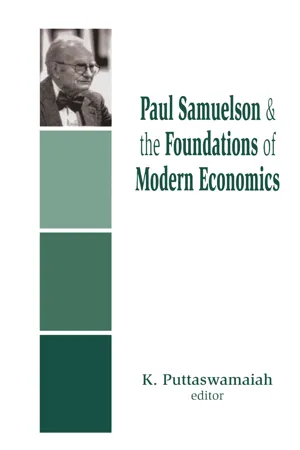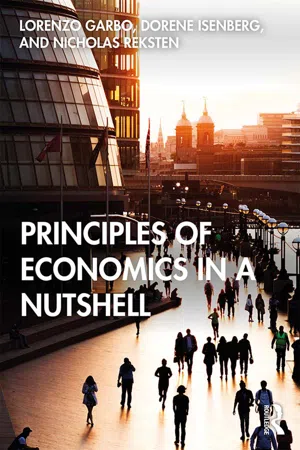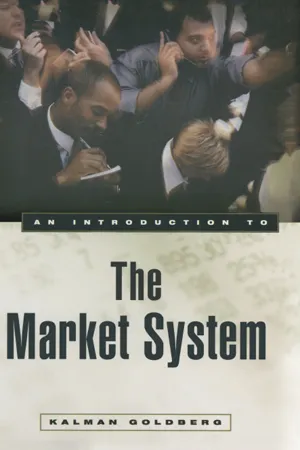Economics
The Market Mechanism
The market mechanism refers to the process by which supply and demand interact to determine the prices and quantities of goods and services in a market economy. It relies on the forces of competition and self-interest to allocate resources efficiently. Through this mechanism, prices act as signals that guide producers and consumers in making decisions about what to produce and consume.
Written by Perlego with AI-assistance
Related key terms
9 Key excerpts on "The Market Mechanism"
- K. Puttaswamaiah(Author)
- 2019(Publication Date)
- Routledge(Publisher)
In the first section of this paper, relations between price determination and market mechanism are recalled. In the second section, a market mechanism - Cantillon's rule - is built in the basic pure exchange model and some consequences of this introduction are drawn. A third section is devoted to interpretative remarks and to monetary control. Final section contains some remarks about the history of thought in this field.1. Price Determination and Market Mechanism
In its more general meaning, market is a particular means of co-ordination between individual actions. The peculiarity is that individual actions are decentralised, i.e. the individuals do not know the state of the economy in which they are acting. Besides, such a state is the result of individual actions and it is commonly admitted that it can be different from what market participants expected.A market mechanism is an algorithm by which prices and allocations resulting from a given set of individual actions can be calculated. In a competitive economy these actions concern quantities and not prices. The latter are supposed to be determined by the anonymous market competition. This conception is common to the general competitive equilibrium theory as well as to other price theories (production prices, labour theory of value, etc...). All this can be expressed by the fact that the agents, when they make decisions, take prices as parameters (such prices can be either expected prices or Marx's 'ideal prices' or they can be announced by an auctioneer).In the most advanced price theory - the general competitive equilibrium theory - there does not exist any algorithm which could be interpreted as a market mechanism. It is impossible to calculate market prices and allocations which correspond to individual actions taken for a given vector of parametric prices. Market outcomes are determined only for very particular vectors of parametric prices, i.e.- eBook - ePub
An Introduction to Economics
Concepts for Students of Agriculture and the Rural Sector
- Berkeley Hill(Author)
- 2021(Publication Date)
- CAB International(Publisher)
3 Demand and Supply: the Price Mechanism in a Market EconomyIntroductionThe study of the demand and supply of goods and services, and the way they interact, forms a fundamental part of economics. Indeed, a surprisingly high proportion of economic problems we come across in everyday life can be explained, although perhaps not solved, by a careful examination of the demand and supply of goods or services. It has even been suggested that a parrot could be turned into a passable economist simply by teaching it to say the words ‘demand and supply’ in reply to all questions.By way of introduction to this important area of study let us take an example from agriculture. At various times of the year some farmers want to buy barley while others are willing to sell barley – a demand and a supply both exist. Transactions occur at markets where buyers and sellers can meet each other. These used to be physical places but nowadays this could equally well be Internet websites. Let us imagine that we can select one market on one day (say, in early December) and have the power to ask as many questions as we like. Furthermore, let us imagine that we can dictate what the price of barley is to be.If we take all those who wish to buy barley and tell them that the price will be £100/t on that day – assume this is a high price for the particular season – very few farmers will wish to buy any and the quantity sold will be small. If we say that the price will be £90/t, more buyers will be interested. As the price is lowered, increasing interest will be shown – more farmers will wish to buy and each will tend to buy more. If we make a table of the quantity of barley we could sell at various prices we end up with a demand schedule .If we moved on to suppliers of barley we would find that at a low price the quantity which they would be prepared to sell would be small. But if we offered a higher figure the quantities offered would increase – more sellers would want to sell and each would want to sell a greater quantity. Again we could draw up a table or schedule of prices and quantities of barley which suppliers would be prepared to supply at these prices. - eBook - ePub
Economic Lessons from the Transition: The Basic Theory Re-examined
The Basic Theory Re-examined
- Daniel R. Kazmer, Michele Konrad(Authors)
- 2016(Publication Date)
- Routledge(Publisher)
1 The Basic Market MechanismThe heart of The Market Mechanism is the interaction, in fact, the intersection, of supply and demand. This is the first thing that all economics students learn in their first principles course, so we will not go over it in detail. However, it is interesting to see what this theory has to say about transition economies, and posit some changes to the theory to explain what happened there.The key to a functioning market is that both buyers and sellers are sensitive to price, but in opposite directions. As the price rises, sellers offer more units of the good for sale, while buyers are willing to buy fewer units. For example, assume a simple market in which only one kind of good is for sale. There are nine buyers and nine sellers: each of the buyers wants one unit, and each seller has one unit to sell.In this textbook example of supply and demand, each seller has a different price that she is willing to take for her good and each buyer has a different price that she is willing to pay. For example, at a price of 9 euro, nine sellers are willing to sell, but only one buyer is willing to buy. If the price falls to 8 euro, one high-cost producer drops out, so only eight units are offered for sale. However, at 8 euro, another customer is willing to buy a unit of the good, so quantity demanded rises to two units.Continue this process, and the result is the schedule of quantities supplied and demanded at each price given below (see Table 1.1 ).The same information is displayed in Graph 1.1 , with price on the vertical axis, and quantities supplied and demanded on the horizontal axis. The quantity supplied equals the quantity demanded at only one price, 5Table 1.1 Schedule of Quantities Supplied and DemandedPrice in Euros Quantity Supplied Quantity Demanded 9 9 1 8 8 2 7 7 3 6 6 4 5 5 5 4 4 6 3 3 7 2 2 8 1 1 9 euro. This is also the price at which the supply curve and the demand curve intersect, the equilibrium price for this market. The equilibrium quantity for this market is five units. The term “equilibrium” is also significant. Economics demonstrates that markets move toward the equilibrium point, due to the independent actions of market participants (see Graph 1.1 - eBook - ePub
- Lorenzo Garbo, Dorene Isenberg, Nicholas Reksten(Authors)
- 2020(Publication Date)
- Routledge(Publisher)
3Led by an invisible handThe market
We are now ready to introduce one of the most important conceptual frameworks in the study of microeconomics: the concept of the “market.”3.1Markets: a general introductionDefinition of market : the geographical or conceptual space dedicated to the interactions between economic agents (individuals, firms, and the government) who want to buy a good/service and economic agents who want to sell that particular good/service. Economic agents who want to buy a good/service are said to express a demand for that good/ service. Economic agents who want to sell a good/service are said to express a supply for that good/service. An outcome of the interactions between buyers and sellers of a good/service is the determination of its market price.The function of a market – and the way a market works – can be easily understood if you think of the actual function of street markets. If you happen to visit the bazaar of Istanbul or the souk of Marrakesh, for instance, you will inevitably notice that sellers keep calling prices for what they have to sell, and buyers keep negotiating for better prices. Sellers want to obtain the highest possible price, and buyers want to pay as little as possible. At some point the sale is done, at a price that is a compromise between the higher prices asked by the seller and the lower prices offered by the buyer. In the bazaar or the souk this is all typically done loudly and in the open, not something we see very often, but it is a great example of how all markets actually work, even though they do this less visibly.The function of the market is to make transactions possible, by determining a price at which buyers and sellers are willing to buy and sell the same amount of the good or service in question . Another way to say this is that, in general, a market for a good or service identifies the equilibrium price - eBook - ePub
The Industrial System (Routledge Revivals)
An Inquiry into Earned and Unearned Income
- J. Hobson(Author)
- 2013(Publication Date)
- Routledge(Publisher)
Chapter IX The Mechanism of MarketsII1. Economic bargaining approaches but does not usually reach a definite market price .2. An equilibrium of supply and demand prices involves infinite divisibility of the supply .3. Various restrictions impair the ‘freedom’ of a market .II1. Analysis of the different markets for the sale of factors of production and of goods and commodities shows that free bargaining only operates over a small portion of the industrial field .2. Most final commodities contain elements of surplus which pass into their price by ‘pulls’ or ‘scarcity rents’ at various stages of production .§ 1 .—COMMERCE , or the art of exchange, enables any person with a claim upon some particular product to convert it into a claim upon any other sort of product. A person thus exchanging anything for something else is actuated by one of two motives: either he desires to exchange his superfluous product in order to get some other articles which he wishes to consume, or else he desires to get some materials, tools, or other concrete capital to use in some process of production.All buying and selling has one of these two ends in view, to assist production or to assist consumption, by enabling persons to convert the ownership of some particular goods into the ownership of some other goods.In other words, it enables every person receiving his income in the shape of a claim upon particular goods, which by the use of his labour-power, ability, land or capital he has helped to produce, to realise that claim in any other sort of goods which he prefers.The general economic functions of exchange are two: first, to increase the utility of an income for purpose of consumption; secondly, to increase the utility of the factors of production. In a primitive society where there is no exchange, but where every family is a self-sufficing economic system, the productive power is wasted because it will be necessary for all land, labour and tools to be employed in some few processes without much division of labour or other effective co-operation, while the consumption of the results of labour will be correspondingly restricted. Where exchange is confined within a small local area, thinly peopled, the economy of production and of consumption remain similarly restricted. Every expansion of the area, every improvement of the mechanism of exchange, increases the wealth of each member of the economic society, by enhancing the productive efficiency of his particular factor of production, and by making his command over commodities more general, so enlarging the variety and amount of satisfaction he can get by spending his income. - eBook - ePub
- Kalman Goldberg(Author)
- 2016(Publication Date)
- Routledge(Publisher)
Business firms are free to enter industries in which they can realize high profits and to leave industries in which they incur losses. This mobility is a major feature of the competitive process and is a crucial element in the market system. The firms act independently to maximize their profit and, as a moth instinctively moves toward a flame, the entrepreneurs are drawn to those industries with high profit rates. And, as with the moth, they have a hand in their own misfortune, for their increased output tends to lower the price and thus automatically limit profits to the minimum rate at which firms are willing to continue to produce.The absence of restrictions on the mobility of firms and factors of production permits resources to be shifted to the industries where prices and profits are highest. But these are the very industries whose goods consumers favor, and consumer demand bids up the prices. Hence, firms searching for the profits generated by high prices rush to meet the desires of consumers. Competition ensures that consumer sovereignty is operative, that firms will be willing, indeed eager, to serve the every whim of consumers—provided it is backed up with buying power.The Price MechanismWe have outlined the conditions necessary for a market system to operate. In all economic systems, limited factors of production must be allocated in the production of economic goods according to certain social priorities. In the market system, the priorities are based on consumer sovereignty. Individual consumers decide for themselves, on the basis of their income and tastes, which particular bundle of economic goods will give them maximum satisfaction. If consumers are to call the tune, then a way must be found to make certain that producers get the message and dance to it. The price mechanism is this device in the market system.What to ProduceThe most popular economic goods and services get the greatest play in the markets. Consumers relay their preferences by simply going into the markets to make purchases. Thereby the prices of the more preferred goods are raised, and the prices of those not favored are lowered. Business firms have only one purpose in mind—maximizing profit. It is to their interest, therefore, to respond to the higher prices by increasing the quantity they supply and to curtail production of the rejected goods. Determining What to Produce follows automatically as a consequence of households and business firms following their own self-interests, with the system structured so that the consumer is the ultimate beneficiary, the one whom the system is designed to serve. There is a harmony of interests because the firm cannot make a profit unless it meets consumer wishes. - eBook - ePub
The Poverty of Nations
A Sustainable Solution
- Barry Asmus, Wayne Grudem(Authors)
- 2013(Publication Date)
- Crossway(Publisher)
controls it. The market just happens. Just as we can say, “Gravity is,” whether we can explain it or not, so “the market is.” It does not need to be created by conscious human design. Wherever human beings exist, have freedom of choice, and have a desire to improve their own condition, the market exists.The market economy and its price system are gifts to the world. People did not intentionally create a complex array of exchanges and price signals. Their only goal was simply to improve their lot in life. The free market was the result.At this point, we can explore in more detail just what makes the signaling system of the market work so effectively. The answer is prices. D. Prices are an amazing worldwide source of instant economic informationThe chief virtue of a functioning market is in dispersing and applying socially useful information. Prices and competition, as we will see, do that. Buyers prefer to buy low and sellers prefer to sell high. The prices that are signaled by the market determine their choices.Supply and demand determine the prices of goods and services, as well as wages, interest rates, profits, and losses. The market is the arena in which all these interacting decisions are made. The pricing system of the market is a continual process with an overall tendency toward coordination. It is a process for the discovery and correction of error through multiple exchanges inducing decision makers to produce and sell just what the customer wants.The market is constantly signaling “do more,” “do less,” or “do it differently,” because supply and demand are never constant. The market is a constant discovery procedure that generates large amounts of information about new products, product improvements, and the latest technologies. In all of these areas, prices are needed before buyers and sellers can make decisions. - eBook - ePub
Value-based Marketing Strategy
Pricing and Costs for Relationship Marketing
- Santiago Lopez(Author)
- 2016(Publication Date)
- Vernon Press(Publisher)
The market forces that act on an individual firm also act on the rest; for each customer and firm, there is a function that represents supply and demand. If we add (aggregate) all the functions of all firms and customers, we get a representation of the aggregate supply and demand; that is, the entire market.When a good is scarce, demand is higher than supply, and its price tends to rise. As its price increases, the quantity demanded decreases, thereby rationing a scarce good; when it is abundant, the same mechanism operates by reducing its price and stimulating consumption; this mitigates surplus and waste; therefore, an efficient allocation of resources is achieved.The pricing mechanism also sends valuable signals to the market: if a price is rising, it indicates that either demand is increasing, or supply is not enough; this encourages firms to increase output. If a price is falling, producers receive the signal to reduce output and this prevents overproduction.When supply and demand are balanced, there are neither shortages nor surpluses; therefore, the price mechanism allocates resources efficiently.However, it must be able to operate without any interference. If this mechanism is interfered with, the market´s natural equilibrium is lost, inefficiencies are created, and this leads to surpluses or shortages. - eBook - ePub
- Rob Dransfield(Author)
- 2013(Publication Date)
- Routledge(Publisher)
3 How markets workChapter Outline3.1 Introduction3.1 Introduction3.2 The nature of a market economy3.3 The relationship between price, demand and supply3.4 The construction of demand and supply curves3.5 Changes in the conditions of demand and supply3.6 How to measure elasticity of demand3.7 The role of firms in the market3.8 SummaryChapter ObjectivesBy the end of this chapter you will understand:- The role of the market in the economy
- The four laws of supply and demand
- Reasons why demand and supply change and the impact on market equilibrium
- How to measure elasticity of demand and supply
- The relationship between price elasticity and revenue
- The part that private business organizations play in the market
This chapter shows how prices are determined as a result of the decisions of consumers and producers of goods. Prices act as signals indicating to producers what goods they can make at a profit. Relative prices also signal to consumers which goods they should purchase in order to get value for money.Today, economies in most parts of the world are structured around market systems. The market relates to any situation in which buyers and sellers are in contact with each other for the purpose of making transactions. Consumers express their willingness and ability to purchase goods in the form of demand. Producers express their willingness to make goods available in the form of supply.3.2 The nature of the market economy The economy as a system The economy is a system that creates wealth for citizens. There are three main sectors in the economy:- Firms
- Households
- Government
- Organizes resources for the production of goods and services; and
- Satisfies the wants and needs of people who are part of that system.
In all modern economies the government plays an important role in making economic decisions through government spending, and through government production (i.e. through government-owned and -funded industries). However, in this chapter we will be focusing on the operation of the market primarily by considering the non-government sector of the economy (the private sector). We will be looking at how the market works by examining the interactions between firms and households.
Index pages curate the most relevant extracts from our library of academic textbooks. They’ve been created using an in-house natural language model (NLM), each adding context and meaning to key research topics.








